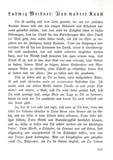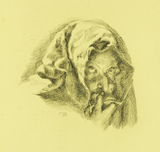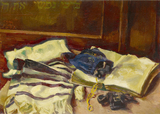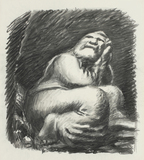Ludwig Meidner, lithograph after a drawing from 1918
Ludwig Meidner, lithograph after a drawing from 1918
I wandered on the fiery path of God until grace made me vain and haughty. Loudly I boasted before the people with that rare wine and looked down my nose at those stuck to the earth-bound and the cave bears. Blinded as I was by arrogance and scorn, grace turned away from me and left me alone again. I was thrust into long forgotten anguish and restlessness. I was again overcome by the weasel of reason and my heart’s singing voice was abruptly still.
from: Ludwig Meidner, I walk into the white celestial wind (In den weißen Windhimmel lauf’ ich hinein), in: September Cry. Hymns, Prayers, Blasphemies (Septemberschrei. Hymnen Gebete Lästerungen), Berlin 1920
Meidner’s engagement with religion in the latter half of the 1910s saw him alternate between periods of devout emotion and serene confidence and periods of doubt and despondence. His search for religious orientation led him to consult theological writings, including texts by Christian authors such as Augustine and Thomas à Kempis. However, Meidner was less interested in an intellectual exploration of theological positions than an intensive, emotional experience of faith, one manifested in the dynamic figures populating his religious images.
In 1918 Meidner took part in the "New Religious Art" exhibition mounted in the Mannheim Kunsthalle and later shown in Dresden. Gustav F. Hartlaub, the exhibition’s curator, describes the wild intensity of Meidner’s depictions, in which "the ecstatically charged hyperbolas of his brush have often distorted, warped, indeed completely shattered, the dervish-like figures of prophets beyond recognition." (Gustav F. Hartlaub, Kunst und Religion, Leipzig 1919, p. 94)
"I, too, was long without solace, shattered, godless, exposed to all errors and vagaries of the moment, isolated and fearful like street sweepings … until one night an inner voice miraculously consoled me …
From then on, I moved easily from the narrow streets onto a shining plain. I looked furtively into old, mystical books and one day realized that Holy Scripture, which had been declared dead, was in fact an inexhaustible wellspring of delights and a source of deep truths. Whereas previously I had leafed through it only with misconception and presumption, I was now seized by the omnipotence of the soothing verses of the psalms and the terrible speeches of Isaiah; they wakened me as if I had been sleeping, whirled me like dust toward the heavens." (from: Ludwig Meidner, Aschaffenburg Diary (Aschaffenburger Tagebuch), in: September Cry. Hymns, Prayers, Blasphemies (Septemberschrei. Hymnen Gebete Lästerungen), Berlin 1920)
Further reading:
Ljuba Berankova and Erik Riedel (Ed.), Apokalypse und Offenbarung. Religiöse Themen im Werk von Ludwig Meidner (Schriftenreihe des Jüdischen Museums Frankfurt am Main Bd. 5), Sigmaringen 1996.







